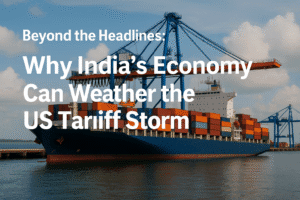Beyond the Headlines: Why India’s Economy Can Weather the US Tariff Storm
While new 25% US tariffs target specific Indian exports worth $40-48 billion, primarily impacting sectors like gems, textiles, and machinery, over half of India’s US exports remain shielded by existing exemptions, notably in pharmaceuticals and electronics. Crucially, India maintains these tariffs will have minimal effect on its massive $4 trillion economy and vast consumer base.
The core friction lies in ongoing trade negotiations, where India refuses any duty concessions on agriculture, dairy, or GM products – a non-negotiable stance rooted in cultural sensitivities and small farmer protection. Despite US pressure tactics, including inflammatory rhetoric and linking tariffs to Russian oil purchases, India enters the critical August talks prioritizing national interests and economic sovereignty. The nation’s consistent global position on these sensitive sectors underscores a commitment beyond immediate trade gains, signaling resilience and strategic patience in the face of external demands.

Beyond the Headlines: Why India’s Economy Can Weather the US Tariff Storm
The recent announcement of 25% US tariffs on select Indian imports sparked immediate headlines warning of a “heavy blow.” However, a deeper analysis reveals a more nuanced picture: India possesses significant resilience, strategic exemptions, and unwavering red lines that will likely minimize the overall economic impact while highlighting critical negotiation challenges.
The Reality of the Impact: Contained, Not Catastrophic
- The Exemption Shield: Crucially, over half of India’s exports to the US ($86.5 billion out of $131.8 billion in FY25) fall under existing US exemption categories (like Section 232), particularly vital sectors like pharmaceuticals and electronics. These remain untouched.
- The $40-$48 Billion Target: Sources indicate only exports worth approximately $40-$48 billion face the new 25% tariff. While significant for specific industries, this represents a manageable portion of India’s total exports and a minuscule fraction (roughly 1%) of its massive $4 trillion GDP.
- Sectoral Pain Points: The tariffs will bite hard in specific areas:
- Gems & Jewellery ($12 billion)
- Textiles/Apparel ($10.3 billion)
- Electrical/Mechanical Machinery ($9 billion)
- Chemicals ($2.34 billion)
- Shrimp ($2.24 billion)
- Animal Products ($2 billion)
- Leather & Footwear ($1.18 billion)
- Companies in these sectors face immediate pressure on competitiveness and margins.
India’s Unshakeable Red Lines: Dairy and Agriculture
Beyond the tariff math lies the true strategic friction point in ongoing trade talks:
- The Non-Negotiable Wall: India has unequivocally stated that granting duty concessions on agricultural products, dairy, and genetically modified (GM) goods is a “no-go area” in any trade agreement.
- Rooted in More Than Economics: This stance isn’t merely protectionist. As officials emphasized, “There are religious sentiments in the dairy sector.” Concerns about the US dairy industry’s use of animal feed clash deeply with cultural and religious practices central to India’s dairy economy. Protecting the livelihoods of millions of small farmers is paramount.
- A Consistent Global Stance: India’s refusal to compromise on these sectors isn’t new; it’s a consistent position upheld across all its trade negotiations globally. This signals deep-rooted priorities beyond this specific US deal.
The Negotiation Chessboard: Pressure Tactics vs. Strategic Patience
- Trump’s “Dead Economies” Gambit: The US President’s inflammatory rhetoric and tariff announcement are widely interpreted by experts as high-pressure tactics to force concessions, particularly targeting India’s purchases of Russian oil as an additional “point of irritation.”
- India’s Calibrated Response: Commerce Minister Piyush Goyal’s response underscores India’s strategy: prioritize national interest, highlight economic strength (“world’s fastest-growing major economy”), and project confidence in its trajectory (path to becoming the 3rd largest economy). This signals India won’t be easily bullied into compromising its core interests.
- The August Deadline: With the crucial sixth round of talks scheduled for August 25th, both sides are positioning themselves. The tariffs amplify pressure, but India enters with clear non-negotiables and underlying economic resilience.
The Human Insight: Resilience Amidst Uncertainty
This situation reveals a fundamental truth about modern India on the global stage:
- Scale as Armor: India’s sheer economic size ($4 trillion GDP, 1.4 billion consumers) provides a formidable buffer against targeted trade actions. Shocks are absorbed more readily.
- Strategic Exemptions are Key: Past negotiations securing exemptions for vital exports like pharma were prescient, acting as an economic shock absorber today.
- Cultural Sovereignty is Non-Tradable: India’s stance on dairy and agriculture demonstrates that certain sectors are deeply intertwined with identity, culture, and mass livelihoods, making them immune to purely economic bargaining. No deal is worth their compromise.
- Pressure Doesn’t Equal Capitulation: While affected sectors will lobby and adapt, India’s government signals it views short-term tariff pain as preferable to sacrificing long-term strategic and cultural interests. The path forward requires creative solutions outside these red lines.
Conclusion: More Than Just Tariffs
The US tariffs are undoubtedly a challenge for specific Indian industries, demanding adaptation and potentially sparking countermeasures. However, characterizing this as a major blow to India’s economy overlooks critical structural buffers and strategic imperatives. The real story lies in the high-stakes negotiation over India’s unwavering red lines in agriculture and dairy, reflecting a nation increasingly confident in asserting its economic priorities and cultural values on the global stage. The outcome of the August talks will hinge less on the tariffs themselves and more on whether the US can find a path forward that respects India’s non-negotiable boundaries.
You must be logged in to post a comment.